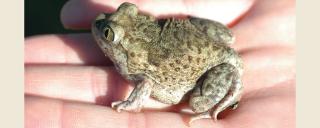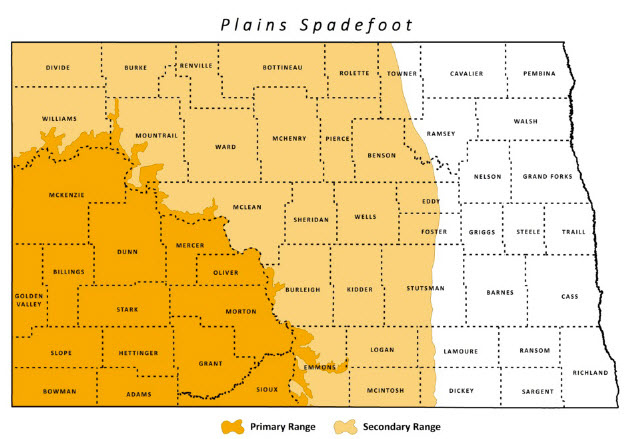
Plains Spadefoot
| Scientific Name | Spea bombifrons |
|---|---|
| General Description | L 1 ½ -2”. Smooth grayish or brown skin with small red or orange tipped warts. A cat-like eye, pronounced boss between eyes, and short, rounded, wedge-shaped spade characterize this toad. |
| Status | Year-round resident. |
| Abundance | Uncommon to locally abundant. |
| Primary Habitat | Dry grasslands with sandy or gravelly soil. |
| Federal Status | No federal status. |
| Reason for Designation | Vulnerable throughout much of its northern range, including Montana. Its geographic range overlaps much of the Great Plains, perhaps one of the more vulnerable ecosystems in North America. |
Locations and Conditions of Key Habitat
Preferred Habitat
Rather dry, open grasslands with sandy or otherwise loose soil are preferred. Typically avoid river bottoms and woodlands. Burrow into the ground until damp soil is reached, sometimes more than 2 feet. Prolific breeders which rarely emerge from the ground except when heavy rains occur, creating small pools of water used for breeding. Temporary wetlands without heavy vegetation such as those found in agricultural fields are easily flooded and may provide tolerable spadefoot breeding habitat. Spadefoot’s may also emerge from the ground during very humid nights. Tadpoles may be omnivorous or sometimes even cannibalistic. Adults eat small invertebrates.
Key Areas and Conditions for Plains Spadefoot in North Dakota
Spadefoots were seen for many years on the eastern edge of Carrington. Focus areas where this species may occur include the Glacial Lake Deltas.
Problems Which May Affect this Species
Habitat
Ephemeral wetlands in which the species naturally breed are at risk of destruction and/or degradation. However, they may be tolerant of a broad range of habitats, even laying eggs in non-native sites such as ditches or flooded agricultural fields. Prairie habitat fragmentation may hinder movements.
Other Natural or Manmade Factors
Use of pesticides and herbicides may impact populations locally. Disease such as ranavirus and chytrid fungus may be very detrimental to amphibian populations.
Research and Survey Efforts
Current Research or Surveys
- North Dakota State University is surveying reptiles and amphibians in SE North Dakota.
- The University of North Dakota is currently studying diseases and parasites in amphibians.
Previous Research or Surveys
- Leonhart studied the effects of climate change on small mammals and herptiles in SW North Dakota in 2006.
- Shaunessy surveyed amphibians as part of a black-tailed Prairie Dog study in 2011.
- Cabarle and Beachy established population levels of amphibians at a number of sites in northern North Dakota in 2011.
- Wheeler and Wheeler (1966) conducted a statewide survey of all amphibians and reptiles, as well as compiled existing records. The toads were found east of the Missouri River and in reasonable numbers.
- The REAP program (1978) found two Canadian Toads in the ponderosa pines, the only records ever found west of the Missouri River.
- Hoberg and Gause (1992) recorded personal observations of Canadian Toads in North Dakota.
- A survey of calling amphibians conducted by Johnson and Batie (1996) found the toads only in the northeastern portion of the known range in North Dakota.
- A compilation of all records in North Dakota by Jundt (2000) listed roughly 60 documentations of the Canadian Toad in the state.
Additional Research or Surveys Needed
Future surveys could include visual encounter surveys or using auto recorders, which turn on to record audio when the humidity or other environmental cues occur at a certain level.
Management Recommendations
- Protect ephemeral wetland habitats from drainage or filling.
- Avoid artificially extending the naturally short hydroperiods of wetlands in arid regions of the state.
- Avoid creating permanent water sources in areas where they are naturally lacking (e.g. southwestern North Dakota In arid regions of the state, restore the natural hydroperiods of wetlands that have been altered to create permanent water sources.
- Encourage the use of alternative water sources for livestock in arid regions of the state.
- Encourage the restoration of grassland habitats that were converted to stock ponds or dugouts.
Monitoring Plans
There currently is no monitoring protocol in place. Monitoring tools could include school classes/programs, the general public, or national monitoring initiatives such as ARMI, NAAMP, or PARC. Amphibian monitoring can and should be directed at several species
2005-2015 Progress
The Canadian Toad maintains its Level I Species of Conservation Priority ranking. Sampling of amphibians has been conducted as part of number of SWG projects. A larger scale survey is currently underway (T-44-R Amphibian and reptile surveys of southeastern North Dakota). Work towards a monitoring protocol is needed.

Note: A listing of works consulted when compiling the information on this page may be found in the 2015 State Wildlife Action Plan.
